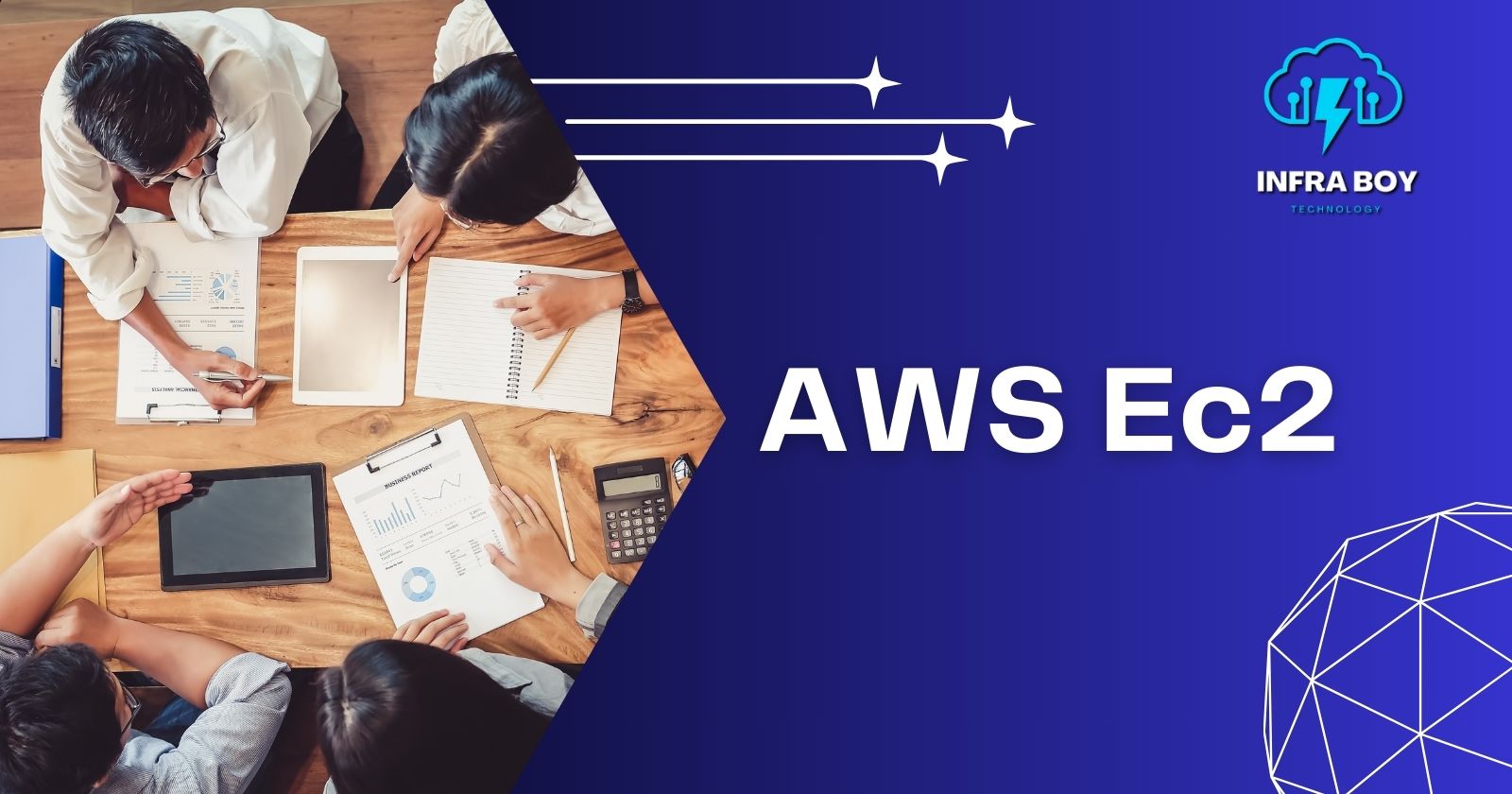Introduction to AWS EC2
 Infraboy
Infraboy
AWS EC2
Amazon Web Services (AWS) Elastic Compute Cloud (EC2) is a fundamental service that provides scalable computing capacity in the cloud. It allows developers to run virtual servers, known as instances, which can be configured and managed easily, giving the flexibility to scale applications up or down as needed.
Key Features of AWS EC2
Scalability and Flexibility: EC2 enables you to quickly scale computing resources up or down to meet changing demand. This means you only pay for what you use, optimizing cost efficiency.
Variety of Instance Types: AWS offers a wide range of instance types, optimized for different use cases such as general-purpose computing, memory-intensive applications, high-performance computing, and more.
Storage Options: EC2 provides multiple storage options, including Elastic Block Store (EBS) for persistent storage and instance store for temporary storage, catering to different performance and durability requirements.
Networking Capabilities: With features like Virtual Private Cloud (VPC), Elastic IP addresses, and various networking configurations, EC2 ensures robust and secure networking for your instances.
Security and Compliance: EC2 integrates with AWS Identity and Access Management (IAM) to control access to resources, and it complies with various industry standards and certifications, ensuring your data is secure.
Automation and Management: Tools like AWS Auto Scaling, Elastic Load Balancing (ELB), and CloudWatch enable automated scaling, load balancing, and monitoring of instances, simplifying management and optimization of applications.
Use Cases of AWS EC2
Web Hosting: Host websites and web applications with ease, leveraging EC2’s scalability and global infrastructure.
Big Data and Analytics: Run data-intensive applications, analyze large datasets, and process big data using high-performance instances.
Machine Learning: Train and deploy machine learning models using powerful GPU instances.
Development and Testing: Create isolated environments for development and testing without investing in physical hardware.
AWS EC2: Instance Limits
When using AWS EC2, understanding the minimum and maximum limits of instances is crucial for effective resource management and planning. Here’s a brief overview:
Minimum Limits
- Instance Size: The smallest instance size available in EC2 is the
t4g.nanoinstance type, which offers 2 vCPUs and 0.5 GiB of memory. This type is ideal for lightweight applications and low-traffic websites.
Maximum Limits
- Instance Size: For the largest instance sizes, AWS provides instances like the
u-24tb1.metal, which offers up to 448 vCPUs and 24 TiB of memory. These instances are designed for extremely demanding workloads such as large-scale SAP HANA, high-performance computing (HPC), and big data processing.
Account Limits (Quota)
AWS sets default quotas (limits) on the number of instances and resources you can use per region to prevent overuse and manage resources efficiently:
On-Demand Instances: Each AWS account has default limits on the number of running On-Demand instances. For example, you might be limited to 20 instances per region initially, but this can vary by instance family.
Spot Instances: Spot instance limits are separate and can be adjusted based on your usage and requirements.
Reserved Instances: There’s no explicit limit on the number of reserved instances you can purchase, but your purchases are subject to the same per-region instance limits.
Elastic IP Addresses: By default, you can have up to 5 Elastic IP addresses per region.
VPCs, Subnets, and Security Groups: There are also limits on the number of VPCs, subnets, and security groups per region, which are essential for networking configurations. For instance, you can have up to 5 VPCs per region.
Adjusting Limits
If the default limits do not meet your needs, you can request limit increases:
Service Quotas: Use the AWS Service Quotas dashboard to view your current limits and request increases.
Support Center: You can also request limit increases through the AWS Support Center by submitting a request ticket.
Types of AWS EC2 Instances
AWS EC2 instances come in a variety of types, each optimized for different use cases. Here’s an overview of the main categories and some specific instance types within each category:
1. General Purpose Instances
These instances provide a balance of compute, memory, and networking resources and can be used for a variety of diverse workloads.
t4g:
t4g.nano,t4g.micro,t4g.medium(powered by AWS Graviton2 processors)t3:
t3.micro,t3.mediumm6i:
m6i.large,m6i.xlarge
2. Compute Optimized Instances
Designed for compute-intensive applications that benefit from high-performance processors.
c6g:
c6g.medium,c6g.large(powered by AWS Graviton2 processors)c5:
c5.large,c5.xlarge
3. Memory Optimized Instances
Ideal for memory-intensive applications, including database workloads and in-memory caches.
r6g:
r6g.large,r6g.xlarge(powered by AWS Graviton2 processors)r5:
r5.large,r5.xlarge
4. Storage Optimized Instances
These instances are optimized for workloads that require high, sequential read and write access to large data sets on local storage.
i3:
i3.large,i3.xlarged2:
d2.xlarge,d2.2xlarge
5. Accelerated Computing Instances
Designed for applications that benefit from hardware accelerators, such as GPUs and FPGAs.
p4:
p4d.24xlarge(for machine learning and high-performance computing)g5:
g5.xlarge,g5.48xlarge(for graphics-intensive workloads)f1:
f1.2xlarge,f1.4xlarge(for customizable hardware acceleration using FPGAs)
Example Use Cases for Each Instance Type
General Purpose (e.g., t3, m6i): Ideal for web servers, small databases, and development environments.
Compute Optimized (e.g., c6g, c5): Suitable for compute-bound applications like batch processing, high-performance web servers, and scientific modeling.
Memory Optimized (e.g., r6g, r5): Best for in-memory databases, large caches, and real-time big data analytics.
Storage Optimized (e.g., i3, d2): Perfect for NoSQL databases, data warehousing, and large-scale transactional databases.
Accelerated Computing (e.g., p4, g5, f1): Tailored for machine learning, graphics rendering, and specialized compute tasks that benefit from GPU acceleration or FPGA customization.
Key Points for Exam Preparation: AWS EC2
If you are preparing for an AWS certification exam, particularly the AWS Certified Solutions Architect, Developer, or SysOps Administrator exams, understanding EC2 is crucial. Here are the important points related to EC2 that you should focus on:
1. Instance Types
General Purpose: Balanced compute, memory, and networking (e.g., t4g, t3, m6i).
Compute Optimized: High-performance processors for compute-intensive tasks (e.g., c6g, c5).
Memory Optimized: High memory capacity for memory-intensive applications (e.g., r6g, r5).
Storage Optimized: High sequential read/write access to large data sets (e.g., i3, d2).
Accelerated Computing: GPU and FPGA for high-performance tasks (e.g., p4, g5, f1).
2. Pricing Models
On-Demand Instances: Pay by the hour or second, no long-term commitments.
Reserved Instances: Significant discount for committing to a 1-year or 3-year term.
Spot Instances: Bid for unused EC2 capacity, can save up to 90% compared to On-Demand.
Savings Plans: Flexible pricing model offering lower prices in exchange for a commitment to a consistent amount of usage.
3. Instance Lifecycle
Launching: Understanding AMIs (Amazon Machine Images), instance types, key pairs, and security groups.
Stopping and Terminating: Differences between stopping and terminating instances.
Resizing: Changing the instance type to scale up or down.
4. Storage Options
Elastic Block Store (EBS): Persistent block storage, types include General Purpose SSD (gp2, gp3), Provisioned IOPS SSD (io1, io2), Throughput Optimized HDD (st1), and Cold HDD (sc1).
Instance Store: Ephemeral storage, data is lost when the instance is stopped or terminated.
Elastic File System (EFS): Scalable file storage for use with EC2.
5. Networking
VPC (Virtual Private Cloud): Customizable virtual network for your EC2 instances.
Subnets: Dividing your VPC for organizing and securing instances.
Security Groups and NACLs (Network ACLs): Managing inbound and outbound traffic to instances.
Elastic IP Addresses: Static IP addresses for dynamic cloud computing.
6. Security
IAM Roles: Assigning permissions to EC2 instances.
Security Groups: Stateful firewall controlling traffic at the instance level.
Key Pairs: SSH key pairs for securely accessing instances.
7. Scaling and Load Balancing
Auto Scaling: Automatically adjusting the number of EC2 instances based on demand.
Elastic Load Balancing (ELB): Distributing incoming application traffic across multiple instances.
8. Monitoring and Management
Amazon CloudWatch: Monitoring performance and operational health of instances.
AWS Systems Manager: Managing EC2 instances, including Run Command, Patch Manager, and Parameter Store.
EC2 Dashboard: Viewing and managing EC2 resources from the AWS Management Console.
9. High Availability and Fault Tolerance
Regions and Availability Zones: Distributing instances across multiple locations for redundancy.
Elastic Load Balancer: Ensuring high availability by distributing traffic across multiple instances.
Learn how to launch EC2 with this video :
Subscribe to my newsletter
Read articles from Infraboy directly inside your inbox. Subscribe to the newsletter, and don't miss out.
Written by

Infraboy
Infraboy
We will provide all kinds of the note which is related to IT infra courses like : Networking , Cloud Computing , AWS , CEH , Cyber Security